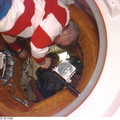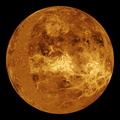
WIKIARCHIVES.SPACE
The Human Spaceflight Archive

Information
- Taken in
- Author
- NASA/JPL
- Description
- This global view of the surface of Venus is centered at 90 degrees east longitude. Magellan synthetic aperture radar mosaics from the three eight-month cycles of Magellan radar mapping are mapped onto a computer-simulated globe to create this image. Magellan obtained coverage of 98 percent of the surface of Venus. Remaining gaps are filled with data from previous Venus missions -- the Venera 15 and 16 radar and Pioneer-Venus Orbiter altimetry -- and data from Earth-based radar observations from the Arecibo radio telescope. Simulated color is used to enhance small-scale structures. The simulated hues are based on color images obtained by the Venera 13 and 14 landing craft. The bright feature near the center of the image is Ovda Regio, a mountainous region in the western portion of the great Aphrodite equatorial highland. The dark areas scattered across the Venusian plains consist of extremely smooth deposits associated with large meteorite impacts. The image was produced by the Solar System Visualization Project and the Magellan Science team at the Jet Propulsion Laboratory Multimission Image Processing Laboratory. The Magellan mission is managed by JPL for NASA's Office of Space Science.
- Created on
- Monday 23 September 1996
- Albums
- US SPACE PROGRAM / PROBES / VENUS / MAGELLAN / Annoted/Science
- Source link
- https://photojournal.jpl.nasa.gov
- Visits
- 18
- Rating score
- no rate
- Rate this photo
- License
- Public Domain
- Modified by WikiArchives
- No (original)
- Downloads
- 1
Powered by Piwigo









